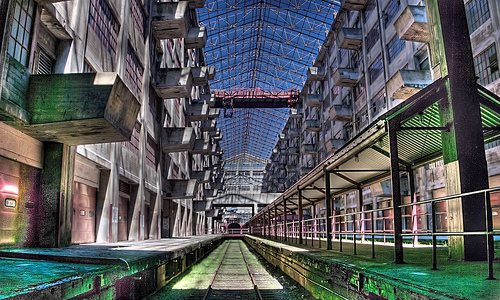The Two Sides of the Brooklyn Economy
Slate has taken a look at Brooklyn artisanal manufacturing and pondered whether it could spread throughout the U.S. and revive our economy. The article notes two special conditions in Brooklyn that have fostered this new type of production: a local support infrastructure of shared kitchens, food blogs and markets such as Smorg; and a big…


Slate has taken a look at Brooklyn artisanal manufacturing and pondered whether it could spread throughout the U.S. and revive our economy. The article notes two special conditions in Brooklyn that have fostered this new type of production: a local support infrastructure of shared kitchens, food blogs and markets such as Smorg; and a big pool of high-end consumers who can pay high prices for top quality goods. To go mass market, or at least nationwide, these businesses would have to grow big and Whole Foods-like, perhaps losing some of their specialness. But it is possible, as Whole Foods has shown. Even if they don’t go mass, if the nation winds up with a lot of small producers, that’s a good thing, the article concluded. Meanwhile, Forbes considered the other side of this equation in a story called “The Hollow Boom of Brooklyn: Behind Veneer of Gentrification, Life Gets Worse for Many.” The article stated: “Poverty citywide, meanwhile, has been rising for three years running and the real Brooklyn, roughly half non-white, remains surprisingly poor. Brooklyn’s median per capita income in 2009 was just under $23,000, almost $10,000 below the national average.” The bank bailout has stimulated Brownstone Brooklyn and even, indirectly, the “creative class,” but the recession has decimated the rest of Brooklyn, the article note. (Not mentioned: The effect of government downsizing and recent cuts to union jobs on working-class Brooklyn.) The New York Times considered the physical evidence of the offshoring of mass manufacturing with a look at the retrofitting of the manufacturing and industrial spaces lying empty along the Sunset Park waterfront. Click through to the story for a slideshow of photos of the Brooklyn Army Terminal. Even The Real Deal had something to say on the subject, with an Editor’s Note (from the Sept. 1 print edition, but linked on the home page today) that located the battle between the small batch and the big box on the street of Williamsburg, which is getting a Whole Foods and maybe a J.Crew.
To some degree, the tension between the mass market and the artisanal is a false canard. If people are selling $10 bags of granola or $14 pickles or $9 bottles of jam, there must be enough wealth to pay those prices. These handcrafted products are a sign of prosperity, not antithetical to it. The wealthy residents in the city are supporting this whole new borough of tinkerers, artists, graphic designers, small-batch entrepreneurs and chefs. But there seems to be a growing cultural gap between big cities and the rest of the country, which is partly being reflected in the presidential race. (I think its reasonable to assume that most rural tea partiers don’t care if their granola is organic). The divide is also economic. Given the general economic uncertainty nationally, big cities like New York have done well — and so has their real estate.
Can Brooklyn Hipsters Save the American Economy? [Slate]
Behind Veneer of Gentrification, Life Worse for Many [Forbes]
Manufacturing Space in Brooklyn Retools for the Modern Tenant [NYT]
The Battle Between Small Batch and Big Box [TRD]
Photo of Brooklyn Army Terminal Building B by Mambo’Dan





Dave, we are so sorry! The commenting system is not working right and we are trying to fix it.